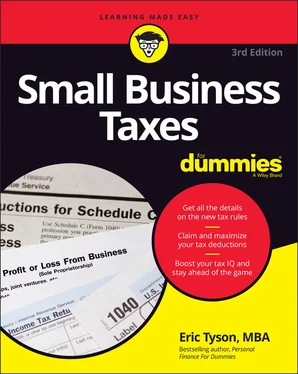1 ...6 7 8 10 11 12 ...16
Corporate income tax rates
As I explain earlier in this chapter, the vast majority of small business owners pay income taxes on their business earnings at the personal income tax rates. That’s because most small businesses are organized as sole proprietorships, which have income taxed as personal income. Also, many other small businesses that are organized as partnerships, LLCs, and S corporations pass through their income to the business owners in such a way that it, too, is taxed as personal income.
Thus, only a small percentage of small business owners have their income taxed as regular, so-called C-corporations. The Tax Cuts and Jobs Act, which took effect in 2018, compressed the previous numerous corporate income tax brackets to just one rate — 21 percent. In the next chapter, I discuss how the tax rate a business pays along with other factors play a role in determining what the best business entity is for your business.
Employment (payroll) taxes
Business owners are responsible for the timely payment of all employee-related payroll or employment taxes. Some of these are withheld from the employees’ pay while others are paid by the employer. Here are the taxes I’m talking about:
Federal income tax withholding
State income tax withholding
Social Security and Medicare taxes (also known as FICA) — half paid by employer, half paid by employees
Federal unemployment tax — paid by employers
State unemployment tax
It’s imperative that you understand and properly withhold and pay all of these taxes on a timely basis. For a list of state tax authorities, visit www.taxadmin.org/state-tax-agencies . Otherwise, you and your business could be subject to stiff penalties and interest charges. Here’s an overview of the frequency with which employment taxes are required:
Larger employers (those who paid more than $50,000 in employment taxes the previous calendar quarter) must submit/deposit their employment taxes every two weeks.
Moderate-sized employers (those who have between $2,500 and $50,000 in employment taxes) can submit their employment taxes monthly.
Smaller employers (those who have less than $2,500 in employment taxes quarterly) may submit their employment taxes with their quarterly employer tax returns. Those with $1,000 or less for income tax withholding and Social Security and Medicare tax payments or federal unemployment tax payments under $500 can pay annually.
Employers must generally deposit these taxes electronically using the Electronic Federal Tax Payment System (EFTPS), which was originally launched in 1996 and doesn’t charge users. This system enables the transfer of your funds from your bank account to the U.S. Treasury.
If your annual employment taxes for your business exceed $1,000, you must file IRS Form 941, “Employer’s Quarterly Federal Tax Return,” each quarter. You can instead file IRS Form 944, “Employer’s Annual Federal Income Tax Return” if your annual employment taxes are less than or equal to $1,000.
To ensure the timely credit of your taxes, plan on submitting them at least one day before they’re actually due. Alternatively, your tax advisor, payroll service, bank, or other financial institution can make the deposit on your behalf.
For more information, visit www.eftps.gov or call 800-555-4477.
Also, remember that self-employed individuals need to pay self-employment taxes, which are Social Security and Medicare taxes. See Chapter 10for all the details.
As you probably already know from your years as a consumer, many towns, cities, counties, and states levy sales taxes on the purchase of particular goods and services. A related tax, known as a use tax, may be levied on the buyer of certain products from out of state.
As the seller of goods or services within a state with a sales tax, your business is obligated to collect and submit said tax to the relevant agency for sales tax collection in your state.
The Streamlined Sales Tax Governing Board was created by the National Governor’s Association (NGA) and the National Conference of State Legislatures (NCSL) in 1999 to simplify sales tax collection. By visiting their website at www.streamlinedsalestax.org/ you can find a list of Certified Service Providers that can help you collect and remit sales tax to the state(s) in which you do business. There is no cost to your business for this service, and using it eliminates any risk of your business being audited for sales tax collections.
Chapter 2
Making Important Business Decisions
IN THIS CHAPTER
 Understanding why many businesses go “solo”
Understanding why many businesses go “solo”
 Assessing the incorporation decision
Assessing the incorporation decision
 Surveying S corporations, partnerships, and limited liability companies
Surveying S corporations, partnerships, and limited liability companies
 Recognizing the value of employee benefits
Recognizing the value of employee benefits
As a small business owner, you face many important decisions. This chapter deals with two big ones that come up in the early days, months, and years of your venture.
First is the type of business entity you’ll operate under — sole proprietor, C or S corporation, limited liability company (LLC), and so on. This decision impacts the liability exposure you have, tax-reporting requirements, and income taxes you and your business will owe.
The second is the benefits your business may consider for yourself and any employees.
Choosing Your Business Entity
Many small-business owners don’t fully consider (or aren’t even aware of) the options they have for the entity under which they conduct their business. Most entrepreneurs default into sole proprietor status for a variety of reasons. But you should be aware of all your choices — such as C corporations, S corporations, partnerships, and LLCs. That’s what I discuss in this section.
If you’re interested in running your own business, odds are you’ll do so as a so-called sole proprietor. About 70 percent of self-employed folks operate their businesses as sole proprietors because setting up a business this way is easier and generally less costly than other options. In this section I discuss the advantages and disadvantages of operating your business as a sole proprietorship.
Understanding the “solo” advantages
The pros of operating as a sole proprietor (going solo) may or may not outweigh the cons for a given small business owner. Each business (and owner) is unique and should weigh the pros and cons. Consider the following advantages:
Simplest tax rules and record keeping compared with other business entity options: You report your business income and expenses on Schedule C of IRS Form 1040 (discussed in detail in Chapter 8), and the net income or loss carries over to your personal income tax return. Though no walk in the park itself, compared with corporate tax forms, Schedule C is easier to complete.
Low cost to establish or discontinue: Without incorporating, it’s a relative snap to get going or shut down such an entity from the perspective of state and local regulations and requirements.
Читать дальше

 Understanding why many businesses go “solo”
Understanding why many businesses go “solo”










